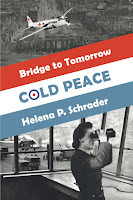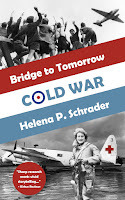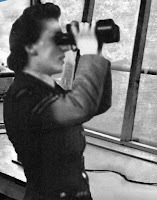The Characters of "Cold War" -- Assistant Section Officer Kathleen Hart, ATC
Cold War is characterized not only by a large cast of characters but by a variety of themes. Key among these is the often overlooked power of women -- even in a time when women were not prominent in positions of power. The post-war years were infamous as a period in which women who had been doing important work during the war years were sent home. They appeared to go meekly in part because many women really were glad to get away from the factories, the shift work, the dangers and the discipline of the services. But some women didn't have a choice: war widows with dependent children.
Kathleen Hart is one of these.
“Mrs Hart, please try to understand.” VirginiaCox argued patiently with the WAAF officer. “Everyone is talking about theseparachutes with sweets attached. There were scores and scores of witnesses, butno one has a photo of it. A picture is worth a thousand words. All I’m asking is that you lend me youradorable little daughter for a few hours. With her bright blond hair, she looksGerman. We can braid it the way the Germans do and dress her in the oldest,most faded clothes she has. I’ve already made a parachute with one of my oldscarves and have attached some Hersey’s chocolate that an American friend gaveme to it.” Virginia held up her contraption. “We can throw the parachute out ofan apartment building window and position Hope below, waiting with upliftedarms. It will be a sensational shot!”
“It would be fake,” Kathleen answered tartlyand indignantly. She did not like this idea at all.
“No more ‘fake’ than most of the films andphotos we made during the war,” Virginia countered. “You know as well as I do thatall those laughing ‘Fighter Boys’ lounging around waiting for a scramble wereposed for the photographers. And so were the images of Bomber Boys intentlywaiting to hear the ‘target for tonight.’ But they weren’t lies. They werestaged, yes, but they replicated reality as accurately as possible. Thatis what I propose to do now. What is so wrong with that?”
Kathleen didn’t have an answer. She lookedover at Hope, who at once started begging. “Please, Mummy! Please!” Kathleenhated being manipulated and all her instincts said this was wrong, but shelacked the arguments to plead her case.
Yes, she could slam the door in the reporter’sface, but that would probably land her in more trouble. The reporter worked forthe Times, and her father sat in Parliament. Perhaps more relevant, the WAAFOC was on very good terms with her and had brought her over, saying she was“sure” Assistant Section Leader Hart would have no objections. Kathleen andParsons had managed to avoid clashes largely by keeping out of each other’sway, but Parsons still had the power to make life very unpleasant for Kathleenif she wanted to. Kathleen preferred to find a compromise now.
She took a deep breath. “I’m sorry, but I’mnot going to let you just borrow Hope. If you want to take Hope anywhere, thenI am coming with you. It is my day off.”
“Oh, splendid!” Virginia agreed withexaggerated enthusiasm.
…
American Skymasters were swooping down at them,and the roar of their engines was deafening. Their wheels and flaps were downas they passed directly overhead, and one could see the oil stains on the wingsand the bolts holding the fuselage together.
“Oh, look!” Virginia exclaimed. “There’s agroup of German children over there. They must be hoping for a sweet drop!Let’s go and talk to them.” Flinging the car door open, she made a beeline for Germanboys and girls, Hope and Kathleen forgotten. Kathleen took a disgruntled Hopeby the hand and followed.
At the sight of three adults approaching froma car with Allied plates, the children grew still and solemn. They probablyfeared being chased away.
“Sprechen Sie Englisch?” Virginiaasked.
“A little,” one girl answered.
“Are you waiting for sweets to be dropped froman aeroplane?”
They all nodded energetically.
“From one of those?” Hope asked pointingupwards, and her mother hushed her.
Virginia asked the German girl, “Have youcaught any sweets before?”
All the children nodded vigorously, and one ofthe younger children said something with a giggle that the older girltranslated. “It is the first chewing gum any of us have ever had.”
“Gum’s bad for your teeth!” Hope informed them.Kathleen put her finger to her lips, harvesting a frown and a stamped foot asshe demanded, “Why can’t I say anything?”
“Because Miss Cox wants to hear what theGerman children have to say.”
“Were you here yesterday and the day before?” Virginiaasked the Germans.
They nodded solemnly.
“But no sweets were dropped?”
They shook their heads.
“But you still come every day?”
“It isn’t just the sweets. Every plane bringsfood or coal or other things we need,” the eldest girl explained. “We watchedthe planes before the sweets were dropped, too. As long as the planes come, mymother says, we won’t have to submit to the Ivans.”
Good answer, Kathleen thought, and she glancedup just in time to see a USAF Skymaster that was almost on top of them start torock back and forth. Pilots often did that to “wave” to girlfriends or parents,but the wild reaction of the children took her by surprise. They startedjumping up and down and waving with both hands; their high-pitched voices deliveredear-splitting, cacophonic yells of glee. Hope instinctively joined in withouteven knowing what it was all about.
The next thing Kathleen knew, tiny parachuteswere opening over their heads with chocolate bars and packages of gum hangingfrom them. The children’s shouts of joy reached a fever pitch, almost blottingout Virginia’s furious screams; her photographer had left his camera in thecar.
It was too late for a photo. The last of theparachutes with two Babe Ruths swaying from some strings was floating down towardsoutstretched little hands. Kathleen heldHope back just in time. Hope stamped her foot again and whined, “Why can’t Ihave some?”
“Because we have sweets rations. Thesechildren don’t,” Kathleen told her firmly. “I’ll give you some chocolate whenwe get back to Gatow.”
Returning her attention to the Germanchildren, Kathleen was astonished to see that rather than tearing open thewrappers and eating whatever they could capture, the children first pooledtheir treasures and then shared them out with scrupulous fairness. In the end,there were three chocolate bars too many. Earnest discussion followed in Germanbefore these were handed to three children, who stowed them away in a pocket,evidently for absent siblings. This gesture more than anything struck a chordin Kathleen. She turned to look at the tail of the receding Skymaster.
Did the young men in that aircraft have anyidea how happy they had just made these children? Could Americans who had neverknown shortages, rationing or hunger grasp what a chocolate bar meant tochildren like these?
They must. Otherwise, they wouldn’t go to somuch trouble to make little parachutes from their cotton handkerchiefs andattach candy to them. Again, she looked toward the Skymaster that had concludedits rollout and was turning off the runway. She squinted, trying to read thenumbers on the tail fin.
The USAF used tailfin numbers to identifythemselves to the tower. If she could read the number, then if it ever came toGatow she would recognise it and could try to talk to the pilots. She knew thecrews changed, but she’d at least have a chance of meeting the young men who’dgone to so much trouble to bring happiness to children they didn’t know.
But the Skymaster was too far away. She wouldnever have any way of knowing who had come up with this idea of dropping candy tothe children of Berlin. Yet, most likely he had once dropped bombs on them. Thethought moved her to unexpected tears. Ken had loved making Hope laugh andsmile. She was sure he would have loved to take part in something like this —if only he’d lived to be here. She felt him beside her, smiling.
Kathleen is a character in both of the First two volumes of the Bridge to Tomorrow Trilogy

The first battle of the Cold War is about to begin....
Berlin 1948. In the ruins ofHitler’s capital, former RAF officers, a woman pilot, and the victim of Russianbrutality form an air ambulance company. But the West is on a collision coursewith Stalin’s aggression and Berlin is about to become a flashpoint. World WarThree is only a misstep away. Buy Now
Berlin is under siege. More than twomillion civilians must be supplied by air -- or surrender to Stalin's oppression.
USAF Captain J.B. Baronowsky and RAF FlightLieutenant Kit Moran once risked their lives to drop high explosives on Berlin.They are about to deliver milk, flour and children’s shoes instead. Meanwhile,two women pilots are flying an air ambulance that carries malnourished andabandoned children to freedom in the West. Until General Winter deploys on theside of Russia. Buy now!
Based on historical events, award-winning and best-selling novelistHelena P. Schrader delivers an insightful, exciting and moving tale about howformer enemies became friends in the face of Russian aggression — and how closethe Berlin Airlift came to failing.
Winning a war with milk, coal and candy!




